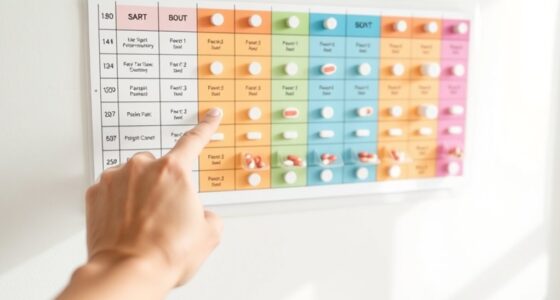Managing terminal delirium with compassion means understanding its causes, recognizing symptoms, and approaching patients gently. Use calming communication, maintain a peaceful environment, and offer reassurance to ease distress. Support families with clear updates and empathetic listening, encouraging presence and touch. Collaborate with a multidisciplinary team to personalize care, ensuring safety, comfort, and dignity. Focusing on holistic and respectful care helps soothe both patients and loved ones, and further guidance can help you provide truly compassionate support.
Key Takeaways
- Approach patients with gentle communication, reassurance, and respectful touch to maintain dignity during delirium episodes.
- Create a calm, familiar environment by reducing noise, dimming lights, and sticking to routines to minimize overstimulation.
- Engage families with clear, empathetic communication, encouraging presence, gentle touch, and spiritual support for emotional comfort.
- Collaborate with a multidisciplinary team to tailor individualized, non-pharmacological interventions and ensure holistic, safety-focused care.
- Recognize symptoms early and provide compassionate, supportive care that emphasizes emotional well-being, safety, and patient comfort.
Understanding the Causes and Symptoms of Terminal Delirium

Understanding the causes and symptoms of terminal delirium is essential for providing appropriate care. You should recognize that it often results from multiple factors, including metabolic imbalances, infections, medication side effects, or organ failure. These triggers can cause sudden changes in mental status, leading to confusion, agitation, or hallucinations. You might notice fluctuating alertness—patients may seem lucid at times and confused at others. Physical symptoms can include restlessness, tremors, or decreased responsiveness. Recognizing these signs early helps you differentiate terminal delirium from other conditions. Understanding that it often develops rapidly in the final stages of illness allows you to prepare interventions that can alleviate distress and improve comfort. Additionally, understanding the contrast ratio in imaging can aid in assessing neurological changes associated with delirium. Being familiar with the underlying pathophysiology can guide more targeted and compassionate interventions. Awareness of medical complexities involved in terminal delirium can further enhance your ability to manage symptoms effectively and with empathy. Being aware of these causes and symptoms equips you to respond compassionately and effectively.
Approaching Patients With Empathy and Respect

When caring for patients experiencing terminal delirium, approaching them with empathy and respect is essential to providing comfort and dignity. Your gentle tone, calm demeanor, and attentive presence help create a sense of safety. Even if they’re confused or agitated, acknowledge their feelings and avoid dismissing their experiences. Use respectful language, introduce yourself clearly, and explain your actions patiently. Physical touch, when appropriate, can offer reassurance, but always observe their responses. Remember, their behavior may be a symptom of their condition, not intentional disrespect. Maintaining eye contact, offering reassurance, and listening attentively demonstrate compassion. Your respectful approach fosters trust, eases distress, and honors their dignity during this vulnerable time.
Communication Strategies for Families and Caregivers

When communicating with families and caregivers, use clear and calm messages to reduce confusion and anxiety. Pay attention to emotional cues to better understand their needs and concerns. Maintaining a consistent approach helps build trust and provides comfort during challenging times. Incorporating empathetic language can also support emotional well-being and foster a sense of safety and understanding. Recognizing the importance of diversification strategies in financial planning can also be adapted to tailoring communication styles to meet individual emotional and informational needs during difficult conversations. Additionally, being mindful of home decor solutions can help create a more reassuring environment for both families and caregivers. Understanding the AI bifurcation can guide caregivers in navigating technological changes that may impact care delivery and communication methods.
Clear, Calm Messaging
Clear and calm messaging is essential when communicating with a loved one experiencing terminal delirium. Speak slowly, using simple words and a gentle tone. Keep your voice steady and reassuring, avoiding sudden movements or loud noises that might startle them. Use short sentences and affirmations to help orient them and provide comfort. Avoid arguing or correcting misconceptions, as this can increase agitation. Instead, focus on maintaining a soothing presence and conveying safety through your words. Remember, your tone and choice of words can influence their sense of calm. Stay patient and compassionate, understanding that confusion is part of the process. Your clear, calm communication helps create a peaceful environment and supports your loved one’s comfort during this difficult time.
Recognize Emotional Cues
Observing your loved one’s emotional cues can provide valuable insight into their comfort and needs. When you notice signs like agitation, withdrawal, or distress, it’s a signal to reassess their environment or approach. Recognizing these cues helps you respond with empathy and adjust your support accordingly.
Here are some ways to interpret emotional signals:
- Restlessness or agitation – They may feel overwhelmed or uncomfortable, indicating the need for a calming presence or environment adjustment.
- Withdrawal or silence – This could suggest fatigue, confusion, or emotional distress, requiring gentle reassurance.
- Facial expressions or body language – Tense muscles or furrowed brows often show discomfort or fear, prompting you to offer comfort or reassurance.
Consistent Communication Approach
Establishing a consistent communication approach is essential for helping your loved one feel safe and understood during delirium episodes. Use simple, clear language and speak in a calm, gentle tone. Keep your words consistent, so your loved one isn’t confused by changes in your message. Use familiar phrases and maintain eye contact when possible to reinforce connection. Avoid arguing or correcting them, as this can increase agitation. Instead, acknowledge their feelings and reassure them with gentle, supportive words. Consistency in your actions and responses helps create a sense of stability, reducing anxiety. Remember, your calm and steady communication can comfort your loved one, making delirium episodes less frightening and more manageable. Your patience and clarity make a meaningful difference.
Implementing Comfort-Focused Interventions

Implementing comfort-focused interventions is essential for alleviating distress and improving quality of life in patients experiencing terminal delirium. Your goal is to address physical discomfort, reduce agitation, and foster a sense of calm. Start by evaluating each patient’s unique needs and preferences. Use non-pharmacological strategies such as gentle touch, repositioning, or soothing sounds to promote relaxation. Consider medication judiciously to manage symptoms without overly sedating.
Here are key approaches to enhance comfort:
- Prioritize consistent, gentle reassurance and familiar routines to ease anxiety.
- Adjust the environment to minimize noise and overstimulation.
- Collaborate closely with family and caregivers to understand the patient’s preferences and provide emotional support.
Focusing on these strategies helps create a compassionate, patient-centered care experience.
The Role of Environment and Routine in Managing Delirium

Creating a calm and predictable environment plays a crucial role in managing delirium by reducing sensory overload and helping patients feel more secure. You can achieve this by minimizing unnecessary noise, dimming bright lights, and maintaining a consistent setting. Clear, familiar objects and personal belongings provide comfort and orientation. Establishing a routine helps create a sense of stability, reducing anxiety and confusion. Stick to regular times for meals, medication, and sleep, and communicate these routines clearly. Gentle cues and familiar sights or sounds can soothe agitation. Avoid abrupt changes or unfamiliar stimuli that might worsen delirium symptoms. Your goal is to foster a peaceful space that supports orientation, reduces distress, and promotes a sense of safety for your loved one. Consistency in routine management is also essential to support patients through predictable patterns.
Collaborating With Multidisciplinary Teams for Holistic Care

Collaborating with a multidisciplinary team is essential for providing all-encompassing care to individuals experiencing terminal delirium. You’ll combine expertise from various professionals to address physical, emotional, and spiritual needs. This teamwork ensures that medication management, symptom control, and comfort measures are aligned. It also fosters clear communication, minimizes confusion, and promotes consistency in care approaches. Incorporating sound design principles, such as clear audio cues and consistent auditory signals, can enhance communication and reduce patient distress in clinical settings. To deepen your approach, consider:
Multidisciplinary teamwork ensures comprehensive, compassionate care for individuals experiencing terminal delirium.
- Regular interdisciplinary meetings to review patient status and adjust strategies.
- Clear role delineation to prevent gaps or overlaps in care responsibilities.
- Incorporating input from specialists like palliative care, nursing, social work, and chaplains to address holistic needs. Recognizing the importance of care coordination can further improve patient outcomes and team efficiency. Additionally, understanding the significance of digital collaboration tools in healthcare finance can help optimize resource allocation and ensure sustainable care delivery. Being aware of signs of spoilage in medications and supplies can prevent unnecessary discomfort or complications. This collaborative effort helps deliver compassionate, patient-centered care that respects individual dignity and promotes comfort.
Supporting Families Through the Experience

Supporting families through the experience of terminal delirium requires clear communication, empathy, and ongoing reassurance. You should provide honest updates about your loved one’s condition, using simple language that minimizes confusion. Listening actively and validating their feelings helps families feel heard and supported. It’s important to acknowledge their fears and emotional pain, offering comfort without false promises. Encourage questions and explain what they might observe, helping them understand the delirium’s nature and expected course. Reassure families that their presence and gentle touch can provide significant comfort. Offer practical support, such as resources for grief or counseling. Additionally, understanding the horsepower of electric dirt bikes can help caregivers appreciate the physical energy involved, fostering greater empathy during this challenging time. Recognizing the profound father-daughter bond can also aid in providing emotional support to families, emphasizing the importance of connection and shared love. Developing an understanding of email marketing tools can facilitate better communication strategies with families, ensuring timely and compassionate updates. Staying informed about AI in Education advancements can help healthcare providers incorporate innovative approaches to patient and family support. Understanding the significance of angel number soulmate signs can also help healthcare providers offer spiritual comfort and hope. Your compassionate approach helps families navigate this difficult time with dignity, fostering a sense of trust and connection amid uncertainty.
Frequently Asked Questions
How Can Staff Prevent Delirium in Terminal Patients Proactively?
You can prevent delirium in terminal patients by maintaining a calm environment, ensuring proper hydration, and managing pain effectively. Keep their room well-lit and familiar, encourage family presence, and minimize unnecessary noise or disruptions. Regularly assess medication side effects and avoid polypharmacy. Staying vigilant for early signs allows you to intervene promptly, reducing the risk of delirium and promoting comfort and dignity in their final days.
What Legal Considerations Are Involved in Managing Terminal Delirium?
When managing terminal delirium, you need to take into account legal issues like informed consent, patient autonomy, and confidentiality. Make sure you document all assessments and treatments accurately, and respect advance directives if they exist. You also have to communicate clearly with patients and families about prognosis and care options, ensuring you’re compliant with healthcare laws and institutional policies. Staying informed helps protect both you and your patients during this sensitive time.
How Do Cultural Beliefs Influence Delirium Care Approaches?
Cultural beliefs greatly influence how you approach delirium care. You should respect patients’ cultural backgrounds, as they shape perceptions of illness and treatment preferences. By understanding their values, you can tailor communication and interventions to be culturally sensitive, ensuring comfort and trust. Recognizing diverse beliefs about death and mental health helps you provide compassionate, personalized care, ultimately improving outcomes and respecting each patient’s unique cultural perspective.
Are There Any Alternative Therapies Effective for Terminal Delirium?
When exploring alternative therapies for terminal delirium, you might consider options like music therapy, aromatherapy, and guided imagery. These approaches aim to soothe, reduce agitation, and improve comfort. You could also explore herbal remedies or acupuncture, but always consult healthcare professionals first. While evidence varies, these non-pharmacological methods can complement traditional care, helping you provide compassionate, holistic support that respects patient preferences and enhances quality of life during this stage.
How Can We Address Medication Side Effects That Worsen Delirium Symptoms?
You can address medication side effects that worsen delirium by closely monitoring your patient’s response and adjusting doses accordingly. It’s essential to communicate with the healthcare team about any adverse effects. Consider switching to alternative medications with fewer cognitive side effects or using the lowest effective doses. Non-pharmacologic approaches, like environmental modifications, can also help reduce delirium symptoms and minimize the need for medications that may cause side effects.
Conclusion
As you navigate terminal delirium, remember that your compassion can make all the difference. Every moment of understanding, gentle communication, and comfort you provide helps shape a peaceful passing. But beneath the surface, there’s a deeper connection—one that transcends words and actions. Will you recognize the true power of empathy in these fleeting moments? In doing so, you may discover that sometimes, the most profound care is found in simply being present.









